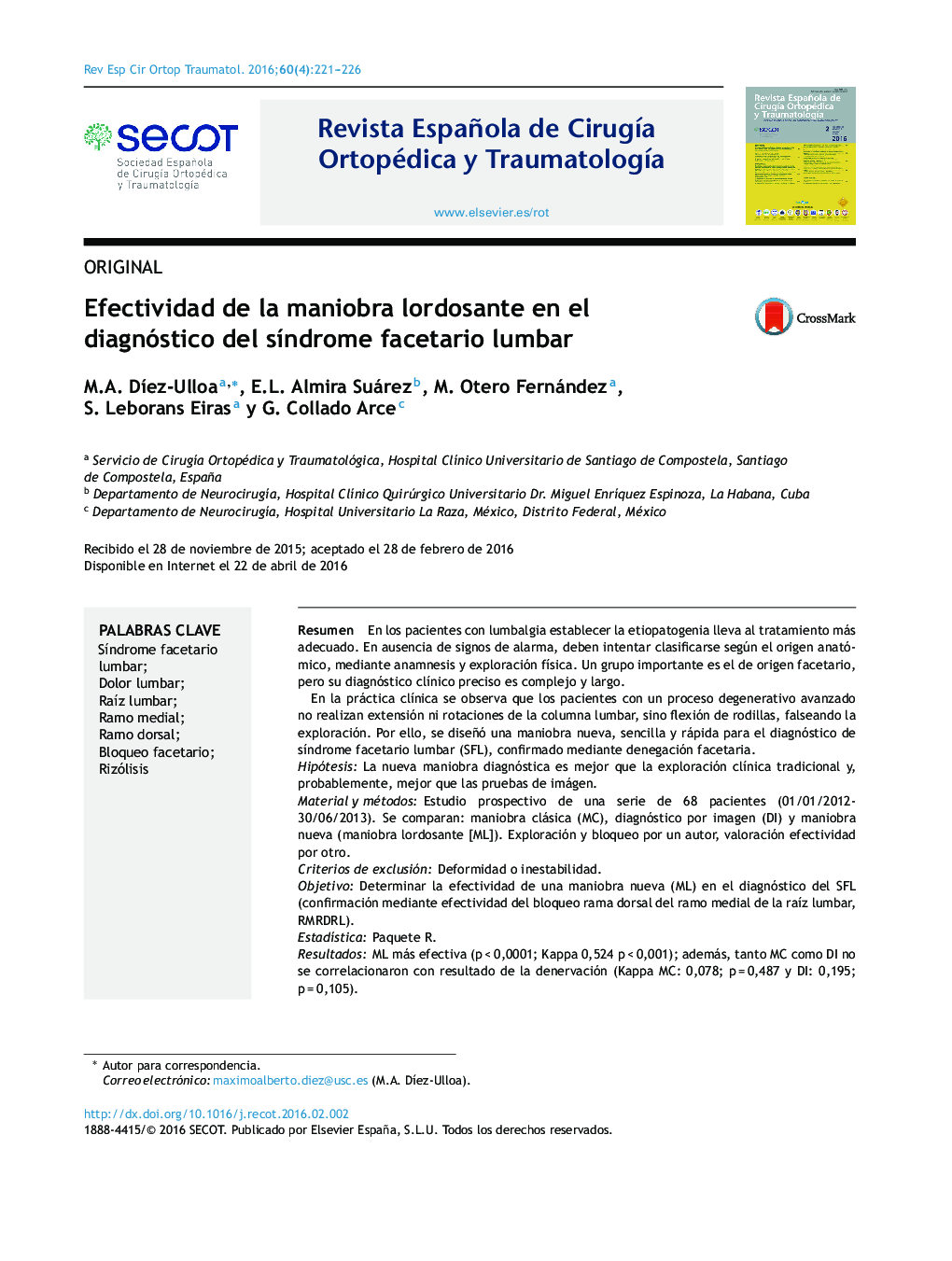| کد مقاله | کد نشریه | سال انتشار | مقاله انگلیسی | نسخه تمام متن |
|---|---|---|---|---|
| 4086149 | 1267932 | 2016 | 6 صفحه PDF | دانلود رایگان |
ResumenEn los pacientes con lumbalgia establecer la etiopatogenia lleva al tratamiento más adecuado. En ausencia de signos de alarma, deben intentar clasificarse según el origen anatómico, mediante anamnesis y exploración física. Un grupo importante es el de origen facetario, pero su diagnóstico clínico preciso es complejo y largo.En la práctica clínica se observa que los pacientes con un proceso degenerativo avanzado no realizan extensión ni rotaciones de la columna lumbar, sino flexión de rodillas, falseando la exploración. Por ello, se diseñó una maniobra nueva, sencilla y rápida para el diagnóstico de síndrome facetario lumbar (SFL), confirmado mediante denegación facetaria.HipótesisLa nueva maniobra diagnóstica es mejor que la exploración clínica tradicional y, probablemente, mejor que las pruebas de imágen.Material y métodosEstudio prospectivo de una serie de 68 pacientes (01/01/2012-30/06/2013). Se comparan: maniobra clásica (MC), diagnóstico por imagen (DI) y maniobra nueva (maniobra lordosante [ML]). Exploración y bloqueo por un autor, valoración efectividad por otro.Criterios de exclusiónDeformidad o inestabilidad.ObjetivoDeterminar la efectividad de una maniobra nueva (ML) en el diagnóstico del SFL (confirmación mediante efectividad del bloqueo rama dorsal del ramo medial de la raíz lumbar, RMRDRL).EstadísticaPaquete R.ResultadosML más efectiva (p < 0,0001; Kappa 0,524 p < 0,001); además, tanto MC como DI no se correlacionaron con resultado de la denervación (Kappa MC: 0,078; p = 0,487 y DI: 0,195; p = 0,105).Hubo correlación entre DI (TAC/RM) con ML (p = 0,024; Kappa 0,289 p = 0,014); aunque no con MC, ni entre DI (radiología simple) con MC ni ML.ConclusionesSe presenta una maniobra diagnóstica para SFL más fiable, rápida y sencilla.La exploración clínica es más efectiva que las pruebas de imagen en SFL.
In lumbar pain patients an aetiopathogenic diagnosis leads to a better management. When there are alarm signs, they should be classified on an anatomical basis through anamnesis and physical examination. A significant group is of facet origin (lumbar facet syndrome [LFS]), but the precise clinical diagnosis remains cumbersome and time-consuming.In clinical practice it is observed that patients with an advanced degenerative disease do not perform extension or rotation of their lumbar spine when prompted to extend it, but rather knee flexion, making the manoeuvre meaningless. For this reason, a new simple and quick clinical test was developed for the diagnosis of lumbar facet syndrome, with a facet block-test as a confirmation.HypothesisThe new test is better than a classic one in the diagnosis of facet syndrome, and probably even better than imaging studiesMaterials and methodsA prospective study was conducted on a series of 68 patients (01/01/2012-30/06/2013). A comparison in between: classic manoeuvre (CM), imaging diagnostics (ID), and the new lordosis manoeuvre (LM) test. Examination and block test by one author, and evaluation of results by another one.Exclusion criteriaDeformity and instability. using a physical.ObjectiveTo determine the effectiveness of a new clinical test (LM) for the diagnosis of LFS (as confirmed by a positive block-test of medial branch of dorsal ramus of the lumbar root, RMRDRL).StatisticsR package software.ResultsThe LM was most effective (p<.0001; Kappa 0.524, p<.001). There was no correlation between either the CM or ID and the block-test results (Kappa, CM: 0.078; p=.487, and ID: 0.195; p=.105).There was a correlation between ID (CAT/MR) and LM (p=.024; Kappa 0.289 p=.014), although not with CM. There was no correlation between ID (plain X-rays) and CM or LM.ConclusionsA new test for diagnosis of LFS is presented that is reliable, quick, and simple.Clinical examination is more reliable than imaging test for the diagnosis of LFS.
Journal: Revista Española de Cirugía Ortopédica y Traumatología - Volume 60, Issue 4, July–August 2016, Pages 221–226
